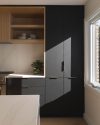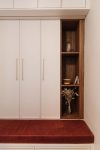
Cabinets play a major role in the renovation of a kitchen or bathroom, which is why an informed choice is key. Here are the main types of cabinets and their characteristics.
The look of your cabinets is far from the only element to consider in your assessment. It is equally important to take materials and manufacturing methods into account, since they will have a direct impact on the durability of your new living space. After all, you’ll want to enjoy your kitchen for years to come!
The main types of cabinet doors
There are two main types of doors.
The slab door: Door made of a single piece.
The shaker door: Door made with a central panel and frame. The shaker door comes in a variety of frame widths.
Most manufacturers also offer the possibility of inserting glass into each of their existing door types, which can add versatility to your decor.
Single-piece

Five-piece

Five-piece with thin panels

Five-piece with window panes

The main materials available on the market
The thickness of the doors and production methods can vary from one manufacturer to another, which will directly influence the quality of the products. A standard thickness can range between ½ inch and 7/8 inches. The thicker it is, the more resistant it is!
1. Melamine (or laminate)

Melamine, also called laminate, consists of a sheet of color dipped in a protective layer called resin, which is then glued to a wood-based panel. There are varying qualities on the market.
Characteristics:
- Vast choice of colors and finishes
- Imitates various wood veneers rather realistically
- Affordable
Note: Certain finishes make finger marks more visible.
2. European laminate

Just like melamine, this is a wood-based panel covered with a sheet of color coated in resin.
Characteristics:
- Vast choice of colors and finishes
- Imitates various wood veneers rather realistically
Note: The panels come in a thickness of ¾ inches, in compliance with European standards, which makes the structures more resistant.
3. Similacquer (or 2D polymer)


Similacquer is made with a new technology based on the fusion of materials. A flexible film is glued permanently onto a wood-based panel. The finish is smooth and silky, akin to lacquer.
Characteristics:
- Several choices of colors and finishes
- Imitates a lacquer finish at a lower cost
- Resistant to humidity
- Color is stable and resistant to exposure to UV rays
Note: While the finish may be similar to lacquer, the assembly joints of the doors remain visible.
5. Lacquer

Lacquer is applied to a medium density fiberboard panel (MDF).
Characteristics:
- Wide range of colors and finishes
- Several door styles available
- Some suppliers offer the possibility of creating a custom color
Note: Lacquer can change color over time, and the finish can chip if subjected to an impact.
6. Wood veneer

Wood veneer consists of a sheet of natural wood glued to a wood-based panel.
Characteristics:
- Wide range of wood species and finishes
- Exotic woods available on demand
- Better resistance to humidity than solid wood
Note: Wood veneer can slightly change color over time, when frequently exposed to sunlight.
7. Solid wood

Several wood types are available in solid wood. Among the most popular, you find maple, cherrywood, walnut, oak, and exotic woods.
Characteristics:
- Wide range of wood species and finishes
- Exotic woods available on demand
- Several types of doors available
- Customization options
Note: Solid wood can change color over time, when frequently exposed to sunlight. It is also sensitive to humidity.
8. Advanced engineering

Advanced engineering products are notable for their extreme resistance. In the industry, Fenix is considered the most resistant material in its category, and is made of sheets coated in thermosetting resins pressed together using heat. The surface is then permanently fixed to a wood-based panel.
Characteristics:
- Resistant to scratching, abrasion, heat, humidity and light
- Can be used as a countertop
- Anti-fingerprint finishes
- Easy to maintain
- Possible to repair micro-scratches using heat (specific to Fenix)
Note: Since this material is of a higher quality than other synthetic materials, its cost is also higher.
Prices
The choice of materials for your kitchen cabinets will significantly influence the total cost of your project.
And what about countertops? To find out what material to choose for your work surfaces, head over here.